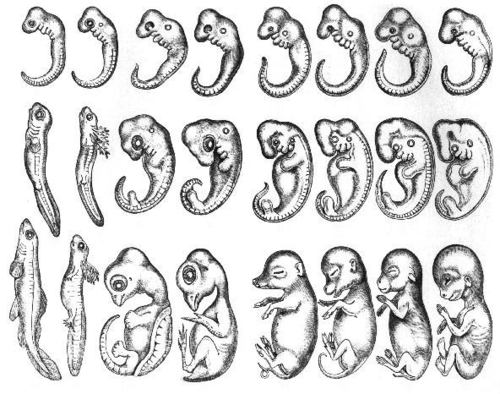READ: Comparative Embryology
READ: Comparative Embryology
We all start as a single cell and soon grow into an embryo. Notice the remarkable details beginning to form. The eyes, backbone, and limb buds are obvious. Think about the amazing complexity that must be going on inside the embryo, and the tremendous amount of growth and development still to come.
After fertilization in animals occur, the fertilized egg is called an embryo. In humans the embryonic stage lasts through the eighth week following fertilization . During this time, the embryo grows in size and becomes more complex. It develops specialized cells and tissues and starts to form most organs.
A few of the developments that occur in the embryo during weeks 4 through 8 are listed in the figure below . By the eighth week of development, the human embryo is about 30 millimeters (just over 1 inch) in length. It has also begun to move.
(Note: the drawings of the embryos are not to scale.)
This picture above was created by early scientists who were looking for similarities and differences among different species. Though the pictures above were simplified to show similarities and there has been some recent controversy regarding the pictures, it opened the door for other scientists to investigate how embryological development can be one way of showing evolutionary relationships.
Comparative Embryology

Some of the oldest evidence of evolution comes from embryology, the study of how organisms develop. An embryo is an animal or plant in its earliest stages of development. This means looking at a plant or animal before it is born or hatched. Centuries ago, people recognized that the embryos of many different species have similar appearances. The embryos of some species are even difficult to tell apart. Many of these animals do not differ much in appearance until they develop further.
Comparative embryology is the study of the similarities and differences in the embryos of different species. Similarities in embryos are evidence of common ancestry. Some unexpected traits can appear in animal embryos. For example, human embryos have gill slits just like fish! In fish they develop into gills, but in humans they disappear before birth. The presence of the gill slits suggests that a long time ago humans and fish shared a common ancestor.
The similarities between embryos suggests that these animals are related and have common ancestors. For example, humans did not evolve from chimpanzees. But the similarities between the embryos of both species suggest that we have an ancestor in common with chimpanzees. As our common ancestor evolved, humans and chimpanzees went down different evolutionary paths and developed different traits.
Summary
- Studying the embryos of organisms also provides evidence that two very different animals could have descended from a common ancestor.


